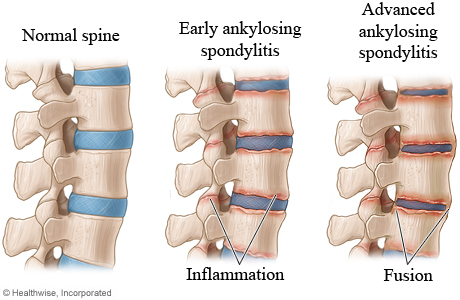
Ankylosing spondylitis is a form of joint inflammation (arthritis) that is long-lasting (chronic) and most often affects the spine. Ankylosing spondylitis commonly causes pain and stiffness, with limited motion in the low back, middle back, neck, hips, chest wall, and heels. Over time, joints in the spine can fuse together and cause a fixed, bent-forward posture.
In early ankylosing spondylitis, there is inflammation of the joints and of the ligaments where they attach near the joints.
In advanced ankylosing spondylitis, there is:
- Fusion of joints in the spine.
- Flattening of the normal curve in the low back.
- Often a flattening of the normal curve of the neck, an increase in the forward curve of the upper back, and bent posture at the hips.
Other joints can become painful and stiff, including those in the shoulders, wrists, hands, knees, ankles, and feet.
Although it is unusual, ankylosing spondylitis can also cause changes such as thickening of the major artery (aorta) and the valve in the heart called the aortic valve. Scarring of the lungs also happens in rare cases. The kidneys and the digestive tract can also be affected.
Current as of: July 31, 2024
Author: Ignite Healthwise, LLC Staff
Clinical Review Board
All Healthwise education is reviewed by a team that includes physicians, nurses, advanced practitioners, registered dieticians, and other healthcare professionals.